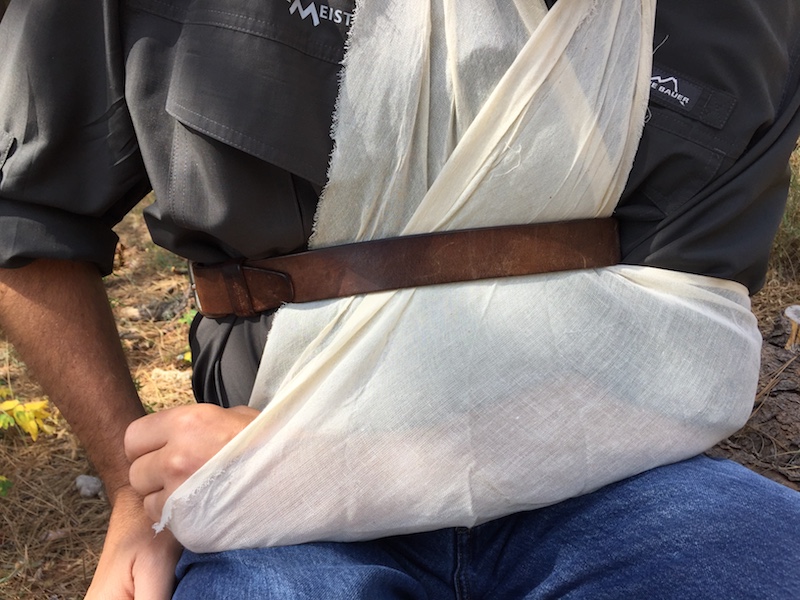Prepare for the Unexpected When Trail Riding
by Robert Eversole

My summer of trail rides and horse camping was wonderful. Until it wasn’t.
You might have heard I took a tumble recently. It’s true. I was riding in the Three Sisters Wilderness in central Oregon when I joined the Unplanned Dismount Club. Although I don’t remember all of it, I got to visit the hospital ER, meet some great doctors, tour the surgery, and now I have a shiny new shoulder! Fun times.
I can’t tell you with certainty what went wrong, although I think it was bees. One moment I was in the saddle taking pictures and the next my head was impacting a tree followed by proof that Newton’s Law of Gravity is true. While I’m finding that narcotic-fueled dreams are not pleasant, I’ve had plenty of time to ponder what went right during my misadventure. The following are four things everyone should do or have when trail riding.
Ride With a Partner
The first thing I did right was to ride with a partner.
Kim McCarell, author of the series Northwest Horse Trail Books, was my riding companion and guide as we rode and horse camped around the Three Sisters area. Kim was not only excellent trail company; she gave me a second set of eyes on my injury and was able to take care of my mule as we made our way off the mountain.
Had Kim not been nearby to help I might still be out there. She helped get my floppy arm stabilized and generally watched me like a hawk during the long slow walk out. She even arranged transportation to the emergency room while we were still on the trail.
Your life may depend on it, so choose your riding partner wisely.
Carry a First Aid Kit (and Know How to Use It)
The second thing I did right was to carry a first aid kit and have the knowledge to use it.
When we found that I couldn’t move my arm, we were able to stabilize it with the first aid kits that we both carried. Between the two kits we were able to get an oddly floppy arm stabilized enough that I could make my way off the mountain.
The emergency room staff was quite impressed with our efforts and the nurses made a point of saying we did a good job of improvising in using a belt to immobilize my shoulder. They also made a point of mentioning that most people don’t know how to help themselves in an emergency.
The incident may have had a different outcome if we hadn’t carried first aid supplies and taken the time and effort to learn how to use them before the ride.
Carry a Communications Device
Being able to call for help is a good thing.
Kim and I both carried tools to contact help in an emergency, and we used them that day. Between the two of us we had cell phones, a personal locator beacon, and a Garmin InReach. With these tools at her disposal Kim arranged for emergency transportation and even let my wife know that there had been an accident. I was awfully grateful that I had options other than sitting on the side of a hill hoping that someone would come along.
It’s important to carry communication devices that work in the area you’re riding. Cell phones don’t work everywhere and not all messengers are created equally. I’ve tried others and I’m very glad that I could rely on my Garmin InReach.
Wear a Helmet
Lastly, I was wearing a helmet.
If scars are sexy, my helmet should be in a pinup calendar. According to my helmet, my head hit a tree on my way to the ground. I certainly don’t remember it. Having a multitude of plates and pins in my shoulder is plenty. I’m glad I don’t have shiny hardware in my head as well.
If you choose to wear a helmet (and I hope that you do) make sure it’s ASTM/SEI certified for equestrian use. My Troxel Sierra model took the beating so that my head didn’t. I guess it’s time for a new helmet.
Well, that’s about it for now. As you can see I’m still typing, slowly and with one hand, but typing! I’ll be back in the saddle as soon as the docs give me the okay. For more trail riding tips, and the world’s largest guide to horse trails and camps, visit www.TrailMeister.com.

Robert Eversole, ”the trail meister,” owns www.TrailMeister.com, the largest database of horse riding and camping areas in the U.S. with free trail and trailhead information, trail maps, and much more to help horse enthusiasts experience the joys of trail riding. Robert is a registered riding instructor with PATH International, a mounted search and rescue team member, and a U.S. Marine who has served on the board of the Backcountry Horsemen of Washington (BCHW). He is enjoying his new career helping fellow trail riders stay found and safe on the trail. When not on the trail, The Trail Meister resides near Spokane, WA and teaches land navigation to a wide variety of outdoor groups across the nation. For North America’s largest horse trail and camping directory, trail tips, and more, visit www.TrailMeister.com.

